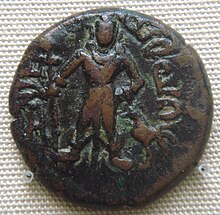Yaudheya

Yaudheya or Yaudheya Gana was an ancient tribal confederation who lived in the area between the Indus river and the Ganges river. They find mention in Panini's Ashtadhyayi and Ganapatha. There are other references to them namely in Mahabharata, Mahamayuri, Brihatsamhita, Puranas, Chandravyakarana and Kashika. As references are spanned from writings of early period to the medieval period, the chronology of Yaudheyas perhaps spans from as early as 500 BCE till 1200 CE. They were in zenith of their power from about 200 BCE to 400 CE.
They are identified with the Jat[1][2][3][4]/Rajput[5] clan Joiyas or Johiya of Bahawalpur and Multan Divisions (Pakistan) and Bikaner, Rajasthan (India).
Puranic Reference
Puranas (e.g. Brahmanda, Vayu, Brahma and Harivamsha) described Yaudheyas as the descendants of Ushinara and Nrigu[6].
Literary and Epigraphical References

We find earliest mention of Yaudheyas in Ashtadhyayi (V.3.116-17 and IV.1.178) of Panini (c.500 BCE) where Yaudheyas are mentioned amongst Ayudhajivin Sanghas.
Later, the Junagadh rock inscription (c. 150 CE) of Rudradaman I[7] acknowledged the military might of the Yaudheyas "who would not submit because they were proud of their title "heroes among the Kshatriyas"", although the inscription explains that they were ultimately vanquished by Rudradaman.[8][9]
"Rudradaman (...) who by force destroyed the Yaudheyas who were loath to submit, rendered proud as they were by having manifested their' title of' heroes among all Kshatriyas."
— Junagadh rock inscription [10]
The Allahabad pillar inscription of Samudragupta[11] also mentioned about the Yaudheyas. Varahamihira in his Brihatsamhita (XIV.28 and XVI.22) placed them in the northern division of India.
Numismatic Evidences

Their territory included on the west – Sutlej, Depalpur, Satgarha, Ajundhan, Kahror, Multan, on the east - Bhatner, Abohar, Sirsa, Hansi, Panipat and Sonipat and on the north - Kangra. These were listed based on the assumptions of coin finds. Even Haryana and Panjab were included in the territory they might have ruled.
There isn’t much known about ancient tribes which are mentioned in ancient literature and inscriptions but the existence of a powerful clan known as Yaudheyas has come to light mainly from their coins and coin-moulds found in large number in this area. A large number of their coins depicted the god Brahmanyadeva or Karttikeya[12].
Later Developments
Yaudheyas were the rulers of South-Eastern Punjab and Rajasthan. Even today these areas are inhabited by the Joiyas.
Colonel Minchin, a British historian says that “the extreme north-eastern portion of the state Bahawalpur and a portion of Bikaner, was inhabited by a race called the Yaudheyas to whom General Cunningham, another historian, attributes the foundation of the town of Ajudhan or Ayodhaunne, the battle field, which is evidently connected with their own name of yaudheya or Ajudhiya inscription of Samudara Gupta and at a still early date by Panini in the Junagarh inscription of Rudra Dama. Now as the great grammarian was certainly anterior to Chandra Gupta Maurya, his mention of the Yaudhas proves that they must have been a recognized clan before the time of Alexander. General Cunningham identifies them with the existing tribes of Joiyas, which is included by colonel Tod amongst the 24-ruling race of Rajputana. He sated that this race possessed the same haunts as the Dahia or Dahers, are now extinct, but in fact both these tribes are still found in the Bahawalpur state, and they were converted to the Muhammadan Faith by the well known saint Hazrat Baba Fareed Shaker Gunj, whose shrine is in Ajudhan, and from whom the place derives its modern name of Pakpattan (District in Punjab, Pakistan), meaning 'the ferry of the pure ones'.”
Joiyas today
Geographic distribution
The Joiyas are at present found in the states of Punjab, Uttar Pradesh and Rajasthan in India. And in Bahawalnagar, Bahawalpur, Multan and Sahiwal in Punjab and in Sindh province of Pakistan. Joiyas are considered a Punjabi tribe in Pakistan. Joiyas are known as Joyo in the province of Sindh in Pakistan. The branches of Yaudhey or Johiya at present among Hindu Jats are Kulhari (Kularia), Khichar and Mahil. Some Yaudhey people adopted Islam also.
Religion
Yaudheya or Joiya are Hindus and Muslims.
Joiya Septs
The Joiyas septs are very numerous, 46 being enumerated as principal septs alone. Of these the more important are the Lakhweras, Bhaderas, Daultanas, Nihalkas, Ghazi Khananas and Jalwanas, their ancestor having been designated Naik-o-Kar Bhai or the Virtous Brothers, by Abdullah Jahanian, a muslim saint. Most of the Joiya septs are eponymous, their names ending in -ka and sometimes in -era.
The other principal septs are Akoke, Bhalana, Bhatti, Firozke, Hassanke, Jamlera, Jhagdeke, Jugeke, Lakhuke, Langahke, Laleke, Mihruke, Mummunke, Shaikhuke, Panjera, Ranuke, Sabuke, Sanatheke, Shahbake, Sahuka and Saldera.
Notes
- ^ James Todd, Annals and Antiquities, Vol.II, p. 1126-27
- ^ Thakur Deshraj, Jat Itihas, Delhi, 2002, p. 624
- ^ Jibraeil: "Postion of Jats in Churu Region", The Jats - Vol. II, Ed Dr Vir Singh, Delhi, 2006, p. 222
- ^ Dr Brahma Ram Chaudhary: The Jats - Vol. II, Ed Dr Vir Singh, Delhi, 2006, p. 250
- ^ Cunningham , A. Coins of Ancient India, London, 1891,pp. 75-76
- ^ Pargiter, F.E. Ancient Indian Historical Tradition Motilal Banarasidass, Delhi, 1972 pp.109
- ^ Junagadh Rock Inscription of Rudradaman I, accessed on 23 March 2007.
- ^ Rosenfield, "The dynastic art of the Kushans", p132
- ^ Rapson, "A catalogue of the Indian coins in the British Museum", p.lx
- ^ Source
- ^ Allahabad Posthumous Stone Pillar Inscription of Samudragupta, accessed on 23 Marah, 2007.
- ^ Allan, John A Catalogue of the Indian Coins in the British Museum (Ancient India), London, 1936, Pl. XXXIX.22
See also
References
- Dasgupta, K.K. A Tribal History of Ancient India: A Numismatic Approach, Calcutta, 1974.
- Lahiri, Bela Indigenous States of Northern India (Circa 200 B.C. - 320 A.D.), University of Calcutta, 1974.
